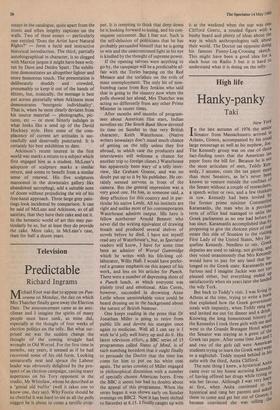Art
Hot cakes
John McEwen
Bruce McLean: recent sculptures and paintings (Whitechapel Art Gallery till 5 June) Terry Atkinson: work 1977 — 1983 (Whitechapel Art Gallery till 5 June; Bir- mingham: Ikon Gallery, 11 June to 9 July; Londonderry: Orchard Gallery, 10 Sep- tember to 8 October; Leeds: City Art Gal- lery, 28 October to 26 November)
Bruce McLean and Terry Atkinson both made their names as artists in the Six- ties — both, in their different ways, as op- ponents of an artistic status quo — and both, though as combative as ever, are now probably enjoying more success and accep- tance than at any time in their careers. These similarities, such as they are, suggest themselves more forcefully as a result of the intelligent juxtaposition of their recent work in a current double-bill at the Whitechapel: to the degree that this new work, in both cases, satirises prevailing ar- tistic attitudes, they are now shown to have a great deal in common, and perhaps to have shared more in the past than ap- pearances indicated. McLean from the outset was very much a joker in the avant- garde pack, his art illustrating the notion that 'humour is the nearest to truth that you can get'. Meanwhile the more party- political Atkinson has sought to bring
about a socialist culture by questioning and combating 'bourgeois theories of in- dividualism' which have in turn led to 'bourgeois careers in art' and a resulting 'plethora of trivial work and under- extended expressive resources'. Their means of expression remain very different — McLean's exhibition is predominantly in the form of huge stone sculptures; Atkin- son's, of texts to which paintings and draw- ings are secondary — but whereas, with McLean, anger is now more to the fore than humour, humour, with Atkinson, is now more to the fore than theory.
McLean has always made art which cock- ed a snook at the prevailing artistic vogue. The most promoted art of the moment is the new German 'ugly' painting, which McLean, fresh from a scholarly stint in Berlin, sees as an expression of German na- tionalism, a cultural war uneasily reminis- cent of World War II and the rest. This new nationalist spirit of division is symbolised by a wedge — sometimes illustrating a spear head, sometimes a segment of cheese — driven between, most obviously, a reclining couple, symbolising global harmony. The fact that McLean's rough-and-ready 'draw- ing' of these symbols in stone with the aid of a road drill recalls the crude sculptures to which the most fashionable German painters have recently turned with stunning financial success, adds the satiric salt.
Upstairs, Atkinson is more obviously satirical in his use of standardised war im- ages — many of them based on photographs in the Imperial War Museum — as pictorial metaphors of current artistic orthodoxies. Thus the capitalist exploita- tion of the masses is satirised as being the same, be the masses ranks of soldiers, workers or art students. Capitalism is equally blamed for the corruption of leaders — in politics, sport and entertain- ment as much as, by implication, in art. These metaphorical nuances will be lost on casual viewers if they fail to read Atkinson's supportive and explanatory
essays in the catalogue, quite apart from the ironic and often lengthy captions on the walls. Two of these essays — particularly one entitled 'Does the Artist have Natural Rights?' — form a lucid and instructive historical introduction. The third, partially autobiographical in character, is so clogged with Marxist jargon it might have been writ- ten by Dave and Deidre Spart. The exhibi- tion demonstrates an altogether lighter and more humorous touch. The presentation is deliberately shoddy and crowded, presumably to keep it out of the hands of elitists, but, ironically, the message is best put across pictorially when Atkinson most demonstrates 'bourgeois individuality'. That is, when he most clearly deviates from his source material — photographs, pic- tures, etc — or most bitterly indulges in what looks like a send up of the David Hockney style. Here some of the com- placency of current art attitudes is suc- cessfully and deservedly punctured. It is certainly his best exhibition to date.
Atkinson's recent interest in the first world war marks a return to a subject which first engaged him as a student. McLean's adoption of sculpture marks a similar return, and seems to benefit from a similar sense of renewal. His five sculptures marooned in the downstairs gallery like abandoned sarcophagi, add a suitable note of doom without prejudicing the wit of his free-hand approach. Three large grey pain- tings look incidental by comparison. It can be said of McLean and Atkinson, as of all satirists, that they have their cake and eat it. In the hermetic world of art this may par- ticularly be so, but at least they do provide the cake. More cake, in McLean's case, than for half a dozen years.











































 Previous page
Previous page